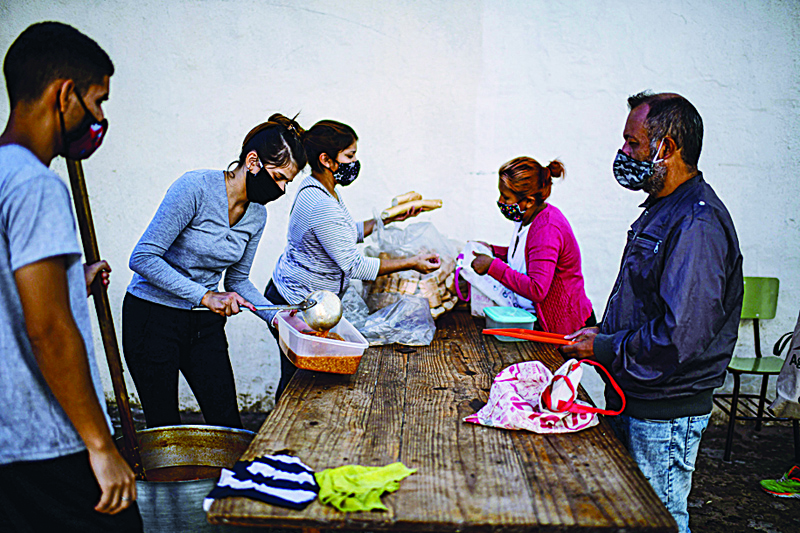 LA MATANZA, Argentina: Women serve food at a soup kitchen in the Puerta de Hierro neighborhood in La Matanza municipality on April 12, 2021. - AFP
LA MATANZA, Argentina: Women serve food at a soup kitchen in the Puerta de Hierro neighborhood in La Matanza municipality on April 12, 2021. - AFP
LA MATANZA, Argentina: Before the coronavirus pandemic, Daisy Garcia used to serve meals to around 80 people at a soup kitchen in a poor slum on the outskirts of the capital Buenos Aires. Now she distributes meals for almost 1,000. "We never, never imagined it would come to this," said the 26-year-old.
Since she emigrated from Paraguay 14 years ago, Garcia has lived in the La Matanza department, the most populous in Buenos Aires province. Ominously, the department is named after a massacre. Garcia's soup kitchen, funded by charitable donations, is located in a two-story building made of concrete - a luxury in this area of slums, where the dirt roads are piled high with rubbish.
"We never stop. Before we worked with 70 to 80 portions but now the pandemic has changed everything: Between 450 and 500 at lunchtime and at night 350 to 400 portions a day. We also work weekends," said Garcia. "Many people need it and many voices are asking for it. People come here from all over the place."
Situated 20 minutes by car from the center of Buenos Aires, La Matanza and its "misery villages", as slums are known here, illustrates the explosion of poverty in Argentina. Poverty levels in the country of 45 million reached 42 percent in 2020 as the pandemic exacerbated three years of economic crisis. Almost half of La Matanza's 1.7 million population live in poverty.
COVID-19 cases are spiraling as the country, and wider Latin American region, reels from a second wave of the pandemic: Last week there were 6,680 new cases in La Matanza, 1,000 more than the previous week. In the western area of La Matanza, drug-related crime hasn't diminished. There's also a lack of electricity, water and sewers. The nearby La Matanza river floods regularly and the slums' streets overflow with filthy water. "We've been abandoned," complained one man.
'They rob each other'
Silvana Grisel Meza wants her two-year-old son to have more opportunities than she has had. "You don't learn anything good in here," she said indicating the slum where she lives: Puerta de Hierro. She's talking from experience. One of her brothers was killed in a settling of scores while another is in prison for murder. She met her husband in a rehabilitation clinic. She's only 20. A housewife, her husband does odd jobs but during the pandemic "it's difficult to get any of those."
The San Petersburgo slum is one of the most violent in the area and surrounded by police control posts. It recently saw a reduction in its violence related to drug crime, but with the pandemic "things went back to the way they were before," said Martin Portillo, a 47-year-old resident. "As they can't get out" due to COVID restrictions, "they rob each other. They need to get money from somewhere." The pandemic has ravaged Argentina, where about 40 percent of people live off the informal sector and where inflation was 36 percent in 2020. Many cannot afford to buy food.
In these neighborhoods, almost everyone uses soup kitchens. In San Petersburgo, Silvia Rodriguez feeds her seven children thanks to a soup kitchen. But a lack of water presents a constant challenge. "If we don't have water, we don't have anything," she said. It's the same in Ciudad Evita where every time Natalia Elizabeth Colbet wants to wash her hands, she has to take a bucket to the communal tap she shares with neighbors. "The truth is, it's a struggle," she said. "With the pandemic, everything has become difficult, too difficult." - AFP

